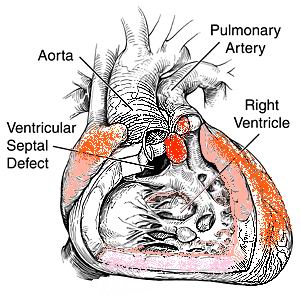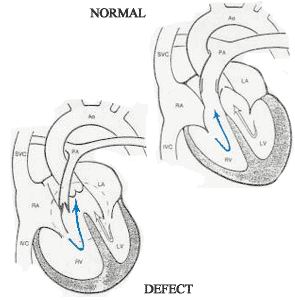
Tetralogy of Fallot (TOF) is a rare and complex congenital heart defect that affects the normal flow of blood through the heart. It is one of the most common cyanotic heart diseases in children, accounting for approximately 10% of all congenital heart defects. TOF is characterized by four distinct heart abnormalities that occur together, disrupting the heart’s ability to pump oxygen-rich blood to the body efficiently.

The four defects include:
Children born with TOF typically show signs of cyanosis—a bluish tint to the skin, lips, and nails—due to insufficient oxygen in the blood. Fortunately, early surgical repair has revolutionized the outlook for children with TOF, and most can lead healthy, active lives with proper medical follow-up.
Tetralogy of Fallot arises during fetal development, typically in the first eight weeks of pregnancy when the heart is forming. The exact cause of TOF is often unknown, but several genetic and environmental factors may contribute:
Genetic Causes:
-
Chromosomal abnormalities such as 22q11.2 deletion syndrome (DiGeorge syndrome), Down syndrome, or other genetic mutations
-
Inherited heart defects from parents or siblings
Maternal Risk Factors During Pregnancy:
-
Poorly controlled diabetes
-
Phenylketonuria (PKU) in the mother
-
Alcohol or drug use, especially during the first trimester
-
Infections, particularly rubella (German measles)
-
Exposure to teratogenic medications or harmful chemicals
While TOF is not always preventable, early prenatal care and genetic counseling can help identify potential risks and manage maternal health effectively.
The signs and symptoms of Tetralogy of Fallot vary based on the severity of the defect and the degree of obstruction in the blood flow to the lungs.
Common Symptoms Include:
-
Cyanosis: Bluish skin, especially around lips and fingertips
-
Heart murmur: Often detected shortly after birth
-
Shortness of breath, especially during feeding or crying
-
Clubbing of fingers and toes
-
Tiring easily during play or activity
-
Fainting or seizures due to low oxygen levels
-
Poor weight gain or failure to thrive in infants
“Tet Spells” or Hypercyanotic Episodes:
A key characteristic of TOF is the occurrence of sudden episodes of deep blue skin, nails, and lips after crying, feeding, or when agitated. These “Tet spells” are caused by a rapid drop in oxygen levels and require immediate medical attention.
Early recognition of symptoms and prompt medical care are crucial in managing the condition effectively.
TOF is usually diagnosed shortly after birth or sometimes even before birth during a routine fetal echocardiogram. Several diagnostic tools are used to confirm and assess the severity of the condition.
Key Diagnostic Tests:
-
Echocardiogram (Echo): Primary test that uses sound waves to create images of the heart, showing structural abnormalities.
-
Pulse Oximetry: Measures oxygen levels in the blood and can indicate cyanosis.
-
Chest X-ray: Reveals the classic “boot-shaped” heart caused by right ventricular hypertrophy.
-
Electrocardiogram (ECG): Detects electrical abnormalities and thickening of the heart muscle.
-
Cardiac MRI or CT scan: Provides detailed imaging, especially helpful before surgery.
-
Cardiac catheterization: Occasionally used to gather more detailed data about blood flow and pressures in the heart chambers.
Timely and accurate diagnosis allows for surgical planning and proper long-term management.
The primary treatment for TOF is surgical repair, which aims to correct the structural defects and improve blood flow to the lungs. Depending on the child’s condition, surgery can be performed early in life.
1. Complete Surgical Repair:
-
Usually performed between 3 to 6 months of age.
-
Involves patching the VSD and widening the narrowed pulmonary valve and arteries.
-
Restores normal oxygen levels and heart function.
2. Temporary (Palliative) Surgery:
-
In some cases, infants may be too small or weak for full repair.
-
A temporary shunt (Blalock-Taussig shunt) is placed to improve blood flow to the lungs until complete repair can be done.
3. Medications:
-
May be given before surgery to manage symptoms.
-
Prostaglandins may be used to keep the ductus arteriosus open and improve oxygenation.
-
Beta-blockers may be used to manage Tet spells.
Post-Surgery Outcomes:
-
Most children recover well and have significantly improved quality of life.
-
Lifelong cardiology follow-up is required to monitor for potential complications such as valve leakage or arrhythmias.
-
Some individuals may need additional surgeries later in life.
While TOF cannot be fully prevented due to its congenital nature, certain preventive and management strategies can improve outcomes:
Prevention Tips:
-
Get early prenatal care and screenings.
-
Ensure rubella vaccination before pregnancy.
-
Avoid alcohol, tobacco, and unapproved medications during pregnancy.
-
Control maternal diabetes and other chronic conditions.
-
Consider genetic counseling if there’s a family history of heart defects.
Long-Term Management:
-
Routine check-ups with a pediatric or adult congenital cardiologist.
-
Regular echocardiograms, ECGs, and exercise tests.
-
Maintain a heart-healthy lifestyle—balanced diet, physical activity, and emotional well-being.
-
Discuss any plans for pregnancy or major surgeries with a cardiologist.
While surgery significantly improves outcomes, some complications can arise, either due to the original defect or post-surgical issues.
Common Complications Include:
-
Pulmonary valve leakage (regurgitation) requiring later valve replacement
-
Arrhythmias, particularly ventricular tachycardia
-
Right ventricular enlargement or dysfunction
-
Residual VSDs (small holes remaining post-surgery)
-
Exercise intolerance or fatigue in adolescence or adulthood
-
Endocarditis, a rare infection of the heart lining (preventive antibiotics may be needed before dental procedures)
Psychosocial Effects:
-
Anxiety or developmental delays in some children due to long hospital stays or repeated procedures.
-
Support from a pediatric psychologist or counselor can be beneficial for the child and family.
Children and adults who have undergone successful TOF repair can lead normal lives with a few lifestyle adjustments and regular medical care.
Infants and Children:
-
Growth usually improves after surgery.
-
Normal school attendance and physical activity are possible, though high-intensity sports may need cardiology clearance.
-
Periodic developmental assessments are recommended.
Adolescents and Adults:
-
Continued monitoring is essential to assess heart function.
-
Many adults can pursue careers, relationships, and have children—though pregnancy requires special care and cardiology oversight.
-
Support groups and heart clinics for congenital heart defects can offer guidance and community.
With modern surgical techniques and compassionate care, the majority of individuals with TOF live active, healthy lives well into adulthood.
The other major Cardiac procedures are:
Few Major Hospitals for TOF are:
Thailand, Malaysia, Singapore, Turkey and India are the most cost effective locations that offer up to almost 80% savings in comparison to the US.
SurgeryPlanet facilitates a plethora of services to the medical treatment traveler also which includes, a hassle free and discounted travel option, a welcome hand at the airport on arrival, travel in an air-conditioned car, round the clock service & support. Your medical evaluation is pre arranged with the least of waiting time. Once your assessment is complete and found medically fit, the procedure is immediately scheduled without a waiting period. Please read through our Services and Testimonials to understand and select your best options.
Tetralogy of Fallot | TOF | cyanosis | bluish purple coloration of skin | VSD | Ventricular Septal Defect | Pulmonary Stenosis | Overriding Aorta | Right Ventricle hypertrophy | ventricles | valvular stenosis | infundibular stenosis | pulmonary valve | hypertrophy | septoparietal trabeculae | biventricle | Coeur-en-sabot | heart murmur | Hospitals TOF | Doctors TOF | Surgery TOF | Cost TOF | Treatment TOF | Destinations TOF | Risks TOF | TOF India | TOF Recovery | TOF Information | TOF Thailand | TOF Malaysia | TOF abroad | TOF overseas | TOF low cost | TOF Singapore
SurgeryPlanet is an Healthcare Facilitator and not a Medical service provider. The information provided in this website is not to be used for diagnosis or treatment of any medical condition or use for any medical purposes. We provide information solely for medical travel facilitation and do not endorse any particular health care provider, hospital, facility, destination or any healthcare service or treatment listed. We are not an agent for, or affiliated to any health care provider, or service listed in our website and is not responsible for health care services provided by them. Choice of hospital or doctor for your healthcare services is your independent decision. Consult your domestic licensed health care provider before seeking the services of any health care provider you learn about from our website.


